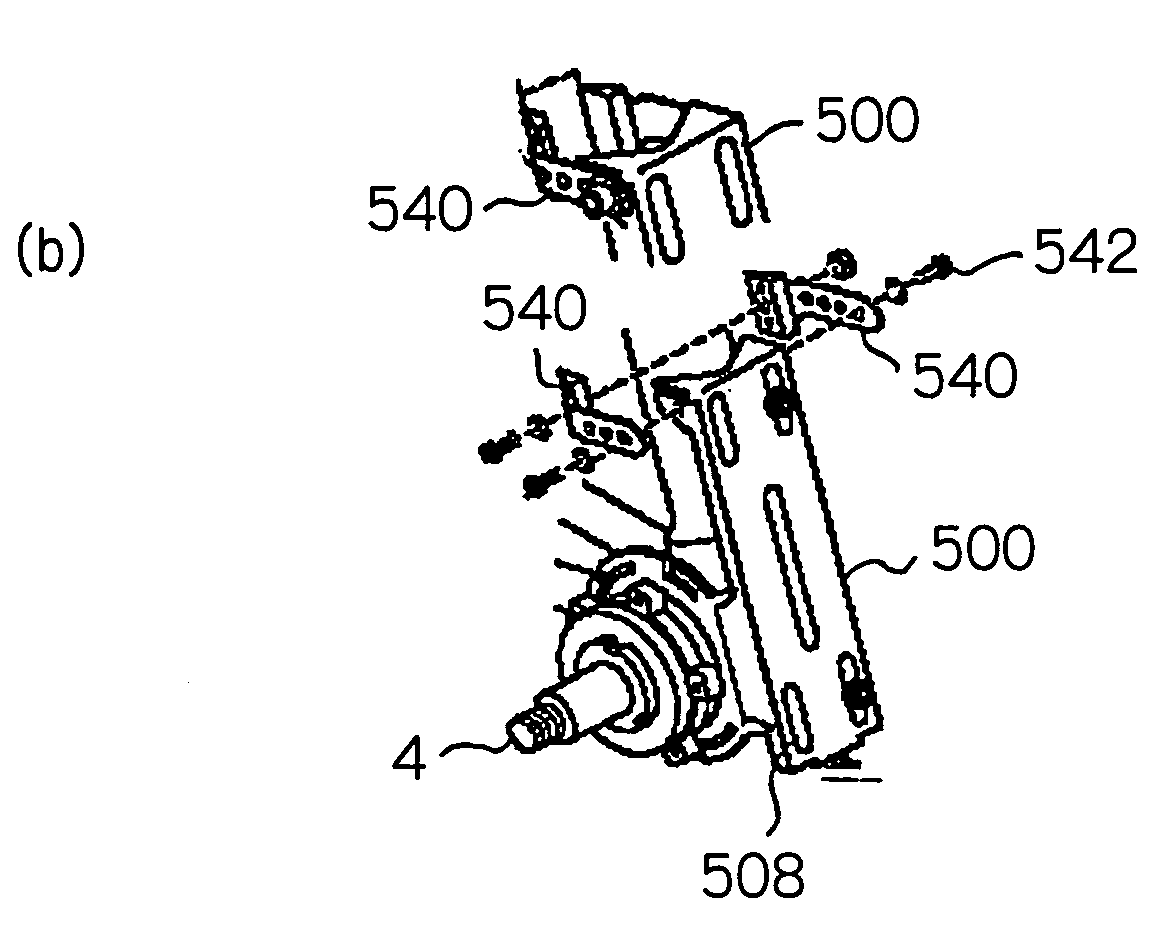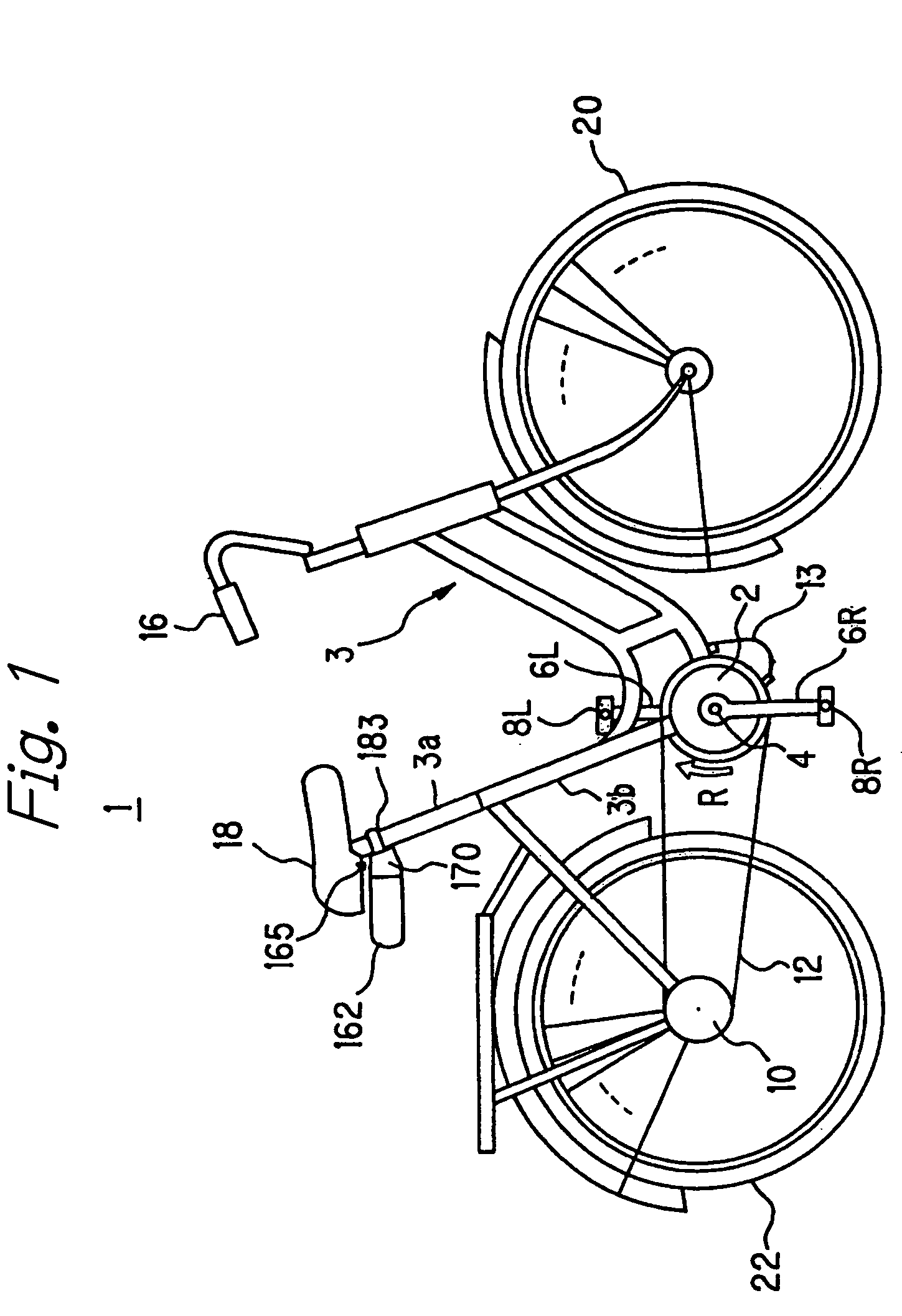Electromotive power assisted bicycle
a technology of electric power and bicycle, applied in the direction of bicycles, gearing details, transportation and packaging, etc., can solve the problems of loss of versatility, increase in cost, and components cannot be adapted to the frame of a regular bicycle, and achieve the effect of compact and simplified system, high processing function
- Summary
- Abstract
- Description
- Claims
- Application Information
AI Technical Summary
Benefits of technology
Problems solved by technology
Method used
Image
Examples
third embodiment
[Third Embodiment of the Unit Mounting Bracket]
[0128]FIG. 19 shows a unit mounting bracket 300 according to a third embodiment, which is adaptable to bicycles with such frames, other than the diamond-shaped frame, as foldable bicycles or a light roadster bicycles, for example. The unit mounting bracket 300 comprises mainly a bottom plate 302, a pair of side plates 304R, 304L extending substantially in a vertical direction from the bottom plate 302, and an end plate 314 bent substantially at a right angle in an end portion of the bottom plate. The pair of side plates 304R, 304L comprises a pair of partial circular segments each having an outer circumference formed into a partial circle, and a pair of side extension segments 306R, 306L, extending from said bottom plate 302 substantially in the vertical direction along the length of the bottom plate as the extension segment of said partial circular segment, wherein said circular segments are provided with side holes 307R, 307L through ...
fourth embodiment
[Fourth Embodiment of the Unit Mounting Bracket]
[0145]Fourth embodiment of the unit mounting bracket will now be described with reference to FIG. 27 and FIG. 29. As shown in FIG. 28, a unit mounting bracket is generally shown by reference numeral 500, and comprises mainly a bottom plate 502, a pair of side plates 504R, 504L extending substantially in a vertical direction from said bottom plate 502, a frame engaging portion 512 formed in one end of said bottom plate and an end plate 514 bent substantially at a right angle in the other end of said bottom plate.
[0146]A V-shaped concave surface to be engaged with the frame is formed in the frame engaging portion 512, while in the end plate 514 is formed a sliding-motion hole 516 which is to be engaged with a bolt (524 of FIG. 1) for allowing the electromotive power output unit box 13 to move slidably.
[0147]The pair of side plates 504R, 504L comprises a pair of partial circular segments, each having a periphery formed into a part of circ...
first embodiment
[First Embodiment of the Battery Bracket]
[0195]A detailed configuration of the battery bracket 165 according to a first embodiment will now be described with reference to FIGS. 21 through 24.
[0196]FIG. 21 shows a lower plan view, a front elevation view and a side elevation view of the bracket member 170. The bracket member 170 comprises a box section 171 configured to house a part of the battery 162 and an extension plate section 175 extending from a top plate 173U of the box section.
[0197]The box section 171 is defined by the top plate 173U, a bottom plate 173B, a pair of left and right side plates 172R, 172L, a curved section 178 formed into a curved contour mating to a frame of the seat post 3a so as to clamp it, mounting faces 174R, 174L located adjacent to the curved section 178 in the left and the right sides thereof to be used as mounting faces which are to be engaged with the bracket retainer 183 when the battery bracket 165 is mounted to the body frame, and a connecting sur...
PUM
 Login to View More
Login to View More Abstract
Description
Claims
Application Information
 Login to View More
Login to View More - R&D
- Intellectual Property
- Life Sciences
- Materials
- Tech Scout
- Unparalleled Data Quality
- Higher Quality Content
- 60% Fewer Hallucinations
Browse by: Latest US Patents, China's latest patents, Technical Efficacy Thesaurus, Application Domain, Technology Topic, Popular Technical Reports.
© 2025 PatSnap. All rights reserved.Legal|Privacy policy|Modern Slavery Act Transparency Statement|Sitemap|About US| Contact US: help@patsnap.com



